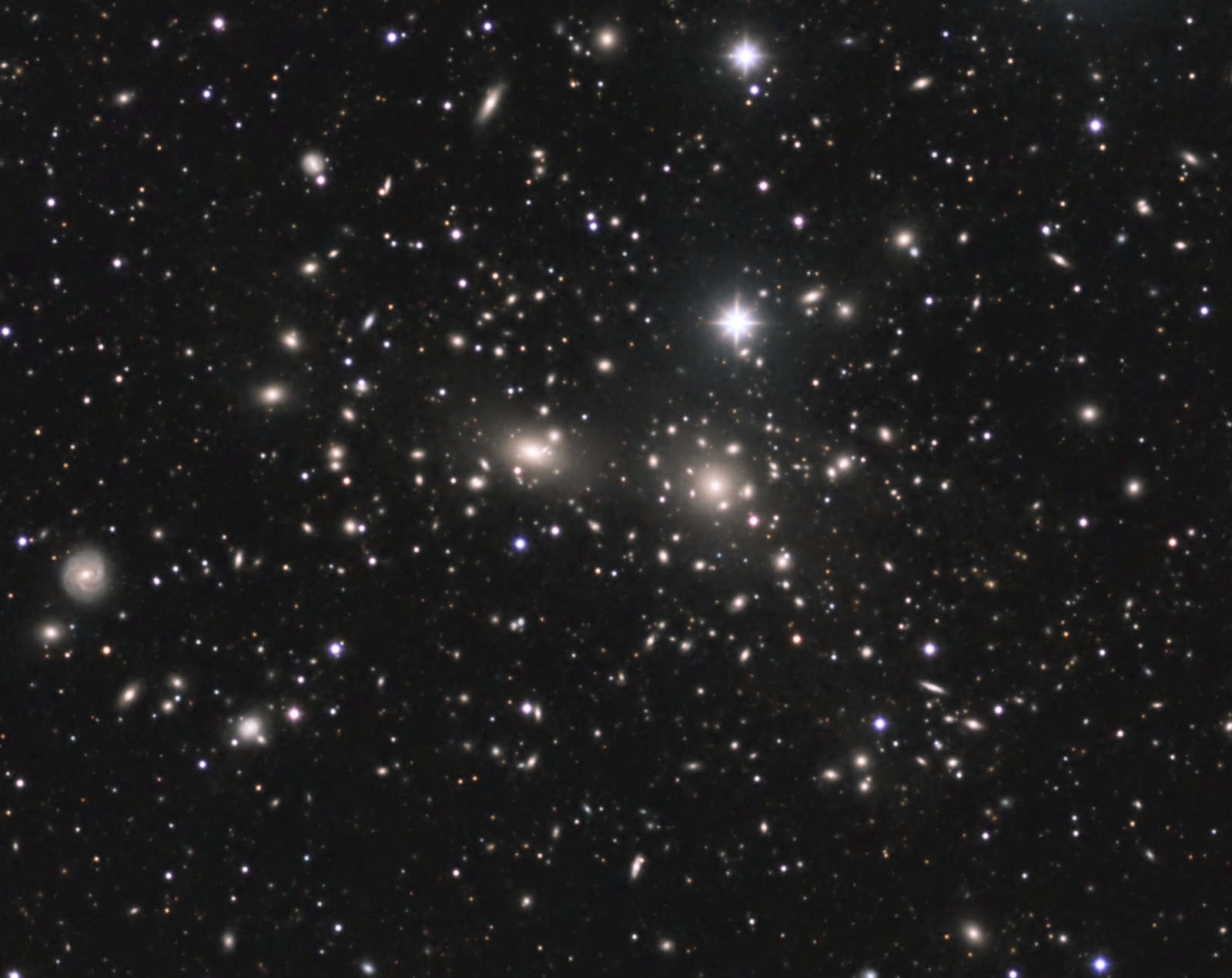Coma Galaxy Cluster

Click image for full size version
January 4, 2018
The Coma Galaxy Cluster lies in Coma Berenices and contains at least 1,000 galaxies with an average distance of 321 million years. The two large elliptical galaxies in the centre are NGC4874 and NGC4889, and are “supergiant elliptical galaxies.”
While a few of the galaxies show some spiral structure, this image is meant to be looked at as a whole photo. It is just staggering to me that all these galaxies reside in this tiny patch of sky, and each contains billions of stars. Just to put a point on that idea, have a look at the uncropped image, that reveals even more galaxies.
I’ve prepared an annotated version of the image above as well as one for the wider field. In both, NGC and IC objects are marked and labelled. The fainter and more numerous PGC galaxies are also marked, but not labelled. Look closely and you’ll see many more galaxies that aren’t in the NGC, IC or PGC catalogues, and therefore not marked in the annotated images.
Tekkies:
Moravian G3-16200 EC camera (on loan from O’Telescope), Optolong R, G and B filters, Takahashi FSQ-106 ED IV at f/3.6, Paramount MX. Acquisition with the SkyX unguided. Focused with FocusMax. All pre-processing and processing in PixInsight. Acquired from my SkyShed in Guelph. No moon, average transparency and seeing.
May 13-19, 2017: 30x5m R, 31x5m G and 28m B, unbinned frames (total=7hr30m)
January 14-March 24, 2018: 41x10m R, 43x10m G and 37x10m B unbinned frames (total=20hr10m)
Total integration time 27hr40m
Image scale is about 1.6 arcsec per pixel for this camera / telescope / combination and Drizzle integration
RGB Creation
Creation and cleanup: The BatchPreProcessing script was used to perform calibration, cosmetic correction and registration of all frames. ImageIntegration followed by DrizzleIntegration was used to make the channel masters. The R, G and B masters were cropped to remove edge artifacts and processed separately with DBE, and then combined to make an RGB image which was processed with PhotometricColorCalibration.
Linear Noise Reduction: MultiscaleLinearTransform was used to reduce noise in the RGB image. Layer settings for threshold and strength: Layer 1: 5, 1.0 Layer 2: 3.5, 0.84 Layer 3: 2.5, 0.71 Layer 4: 1.0, 0.55 Layer 5: 1.5, 0.28.
Stretching: HistogramTransformation was applied to the RGB image to make a pleasing, bright image.
Synthetic Luminance
Creation and cleanup of SynthL: The cropped, background-corrected R, G and B masters were combined using ImageIntegration (average, additive with scaling, noise evaluation, iterative K-sigma / biweight midvariance, no pixel rejection).
Deconvolution: A star mask was made to use as a local deringing support image. A copy of the image was stretched to use as a range mask. Deconvolution was applied (80 iterations, regularized Richardson-Lucy, external PSF made using DynamicPSF tool with about 25 stars).
Linear Noise Reduction: MultiscaleLinearTransform was used to reduce noise in the background areas of the synthL file. Layer settings for threshold and strength: Layer 1: 4, 0.88 Layer 2: 3.5, 0.74 Layer 3: 2.5, 0.65 Layer 4: 1.0, 0.35.
Stretching: HistogramTransformation was applied to the SynthL to make a pleasing, bright image.
Combining SynthL with RGB
The processed SynthL was applied to the RGB image using LRGBCombine.
Additional Processing
Noise Reduction and Re-Stretch: TGVDenoise was applied in L*a*b* mode with 1000 iterations with a range mask used to protect high signal areas. This was followed by a HistogramTransformation to raise the black point (but with no clipping).
Sharpening: MultiscaleLinearTransform was used to sharpen larger galaxies (layers 2 and 3; strength 0.12 for each) using a mask to protect stars and background.
Dark Mottling: To reduce dark mottling in the background, the L* channel was extracted from the SynthLRGB with ChannelExtraction. PixelMath was applied with the expression iif($T<0.07+0.5*(median($T)-$T), $T). The modified L* channel was then applied to the colour image using ChannelCombination in CIE L*a*b* mode.
Final Steps: Background, galaxy and star brightness, contrast and saturation were adjusted in several iterations using Curves with masks as required. The ColorMask script was used to make a mask that selected magenta haloes around a few stars. ColorSaturation was used with the mask to reduce these haloes.






AWESOME! as always.
Good to see you are making good use of these cloudy nights this winter.
I love this target(s). So many galaxies.
Very nice! Absolutely stunning!